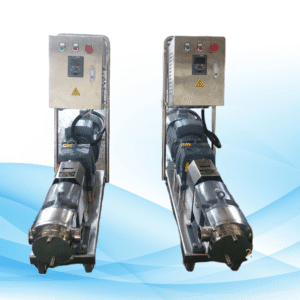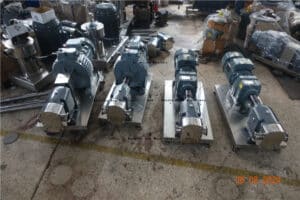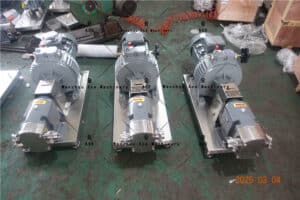Precision of flow is an important thing to keep in mind when dealing with industries such as pharmacy, food and beverage or oil and gas. The quality of a product and its adherence to regulations depend on accurate control over its flow. To put it simply, the term “pump lobe count” refers to how many lobes there are within each rotor of any given rotary lobe pump. The relationship between number of pump lobes versus flow precision can be used as a guideline for selecting pumps optimally, depending on their performances.

Understanding the Lobe Count
Definition and Basic Principles
What’s a Pump Lobe?
A pump lobe is one of the rotating components found within a rotary lobe pump. These lobes are mounted on synchronized shafts. When these shafts rotate together, they cause the volume of the pumping chamber to increase on its suction side, thereby creating vacuum or low pressure which sucks in fluid being pumped through it from the outside world. As these lobes continue rotating round, so does fluid get trapped between them & housing before finally getting released when size decreases again due to continued rotation.
How Lobe Count is Determined
Lobe count in rotary lobe pumps is determined by counting the number of lobes present on each rotor; manufacturers make different designs having various amounts to fit different uses. This feature also affects other things about how smooth or precise flow should be made with this equipment.
Types of Pumps Based on Lobe Count
Single-Lobe Pumps
These have only got one single lobe per every rotor, hence they are simple in terms of design and construction too; since not much accuracy required nor large quantities needed at once – single-lobed pumps can work just fine here! Such characteristics often lead into lower costs during production process, but some disadvantages will always come along, like less accuracy achieved during high-speed operations due to limited number of sealing points between caverns occupied by liquid around housing area where medium enters.
Multi-Lobe Pumps
Multi-lobed pumps have got more than one lobe attached on each rotor; this increases precision as well smoothness during pumping processes, thus making them suitable for areas which need high accuracy levels such those dealing with medicine manufacturing or food processing industry among others. The reason behind is simply because there are more sealing points in multi-lobed pumps than in single-lobed ones, hence pulsation gets minimized, leading to steady flow rate being maintained throughout.
Advantages And Disadvantages Of Different Lobe Counts
Single-Lobe Pumps
Advantages:
- Simple design and construction
- Lower costs of production
- Ease of maintenance
Disadvantages:
- Reduced flow precision
- Increased pulsation rates
- Not recommended for applications requiring high accuracy levels of Multi-Lobe Pumps
Multi-Lobe Pumps
Advantages:
Higher flow precision achieved
Uniform flow rates are established due to absence of fluctuation in speed which occurs when using other types of pumps having less lobes per rotor – this may affect dosage accuracy during drug preparation stage especially if it’s critical that precise amounts be administered at regular intervals within certain time frames.
Disadvantages:
More complex design and construction involved;
Costlier to produce them compared against their counterparts having only a few lobes mounted on every rotor shaft; sometimes parts wear out frequently, thereby necessitating frequent repairs or replacements.
Knowing the difference between single-lobe and multi-lobe pumps will help you make the right choice when selecting a pump for your needs. It all depends on what you want from it – whether high or low flow precision is required, ease of use, cost-effectiveness, etc.
Quantity of Pump Lobes vs Precision of Flow
Theory
Fluid Dynamics and Lobe Interaction
Rotary lobe pumps rely on fluid dynamics for their operation. Efficiency and accuracy in the movement of fluids are determined by how lobes interact. Backflow and pulsations are reduced through creation of sealing points by each lobe. When more lobes are present there is a smoother flow because more seals are made which also increases precision.
Additionally, the number of dead zones within pump chambers decrease with an increase in number of lobes used. Inaccurate flow may result from areas where liquids fail to circulate properly due to stagnation caused by these regions termed as “dead zones”. A continuous even stream can be achieved by ensuring that many lobes are involved thus making this device appropriate for applications that need accurate dosage delivery systems and uniform handling of fluids all times.
Mathematical Models
Theories surrounding mathematical models have been advanced so as to explain the relationship between quantities of pump lobes vis a vis precision in flows. Such kind simulations imitate what goes on inside pumping chambers from point zero up until it hits exit pipe. Engineers use them to forecast performances under different configurations.
For instance; one study conducted on new rotor profiles found out that three segment ECE profile type recorded 55% better results compared with conventional designs. This shows us why we should optimize our number of lobes for improved flow precision. There exists much knowledge gained through maths models on how different counts affect flow properties.
Practical Implications
Study Cases
Pharmaceutical Industry Case Study A pharmaceutical firm required accurate dosing pumps for liquid medicine administration. Inconsistencies arose with their initial single-lobe pump system due to unstable flow rates coming in and going out of it. However, multi-lobe systems were later employed which led not only bettering this problem but also achieving high precision flows all through, thus meeting strict regulatory needs where any slight deviation could lead into life-threatening situation.
Food And Beverage Industry Case Study Another example involves food processing plants dealing with thick substances such as syrups or sauces during transfer process between tanks; here too initially one would use single-lobed pumps which caused unevenness as well as wastage hence resulting into increased costs incurred over time before upgrading them eventually into multi-lobed ones thereby reducing losses incurred along lines while at the same time allowing for better product quality control through more uniform distribution achieved within each tank.
Industry Examples
Pharmaceutical Industry The drug industry thrives on accuracy when it comes to flow rate measurements. Wrong dosage may lead to catastrophic results and therefore very strict regulations have been put in place regarding this matter all over the world so as ensure patient safety Multi lobe pumps offer such precise dosages needed for these kinds of critical applications from different sealing points required contributing towards reduction pulsations that cause variations thus ensuring consistent delivery rates.
Food And Beverage Industry For various processes within food and beverage manufacturing consistency is key especially in terms of how much material should be used at any given time. Single lobe pumps tend to let through large amounts of substance at once thereby causing product damage due to overflow Multi-lobed ones on the other hand provide for fine tuning which allows successively smaller proportions per cycle thus achieving higher accuracy throughout production stages even when dealing with thicker mixtures like syrups or sauces where an even distribution might otherwise prove difficult without this type equipment.
Practical Applications and Product Recommendations
Sectors that benefit from high flow precision
Pharmaceutical Industry
In order to dose correctly and maintain consistent quality, the pharmaceutical industry needs accuracy. Multi-lobe pumps are good at reducing pulsation to achieve steady flow rate, which is ideal for this field. It’s very important to have precise control of flow in order to meet strict regulations and ensure safety of patients. Ace Rotary Lobe Pumps perform reliably while gently pumping, making them suitable for use with delicate pharmaceuticals.
Food and Beverage Industry
Similarly, the food and beverage industry greatly benefits from high flow precision. Uniformity in supply ensures that there’s no wastage and also helps in maintaining the quality of products, which should not change over time. Such consistency can only be achieved if one uses multi-lobe pumps, since they are designed specifically to handle thick liquids like syrups or sauces. These types of pumps create even distribution, thus increasing overall efficiency during production. Titan Flow Meters manufactures liquid flow meters that are both accurate and efficient for various industrial processes, including those used in food and beverages.
Recommended Products
A: Ace Rotary Lobe Pumps

Ace rotary lobe pumps have a strong construction with modular design being their hallmark feature among others too numerous mentionable features. They can be configured flexibly thereby enhancing process flexibility as well as operational reliability besides being applicable across low, medium or high viscosity media due to its gentle pumping action. In short, these machines work well under different conditions, including such areas like pharmaceuticals or food processing where other models may fail.
B: Titan Flow Meters
Titan flow meters are built mainly for performance so do not think twice about them if you need precise measurements on your liquids’ movement rates; oval gears, turbine meters etcetera make up part of their range catering all sorts light metals processing needs, but this does not mean other chemicals cannot be measured accurately since even pharmaceutical industries require similar standards too.
Industries that require accurate fluid handling should understand how different numbers of lobes affect flow precision. Higher lobe counts usually provide smoother and more accurate flow rates. This is why multi-lobe pumps are considered best for high precision applications where it is required to have exact quantities delivered over specific periods without any deviations occurring along the way. Therefore, correct selection of a pump will ensure quality products are produced while at the same time increasing operational efficiency within an organization.


















